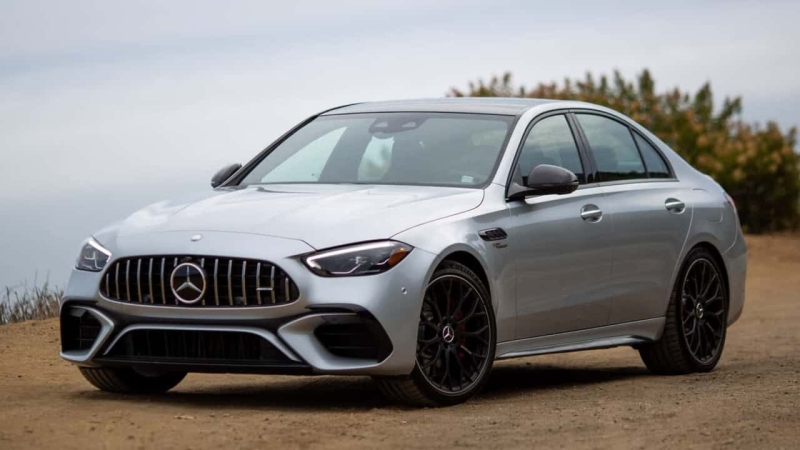The 671-horsepower four-cylinder hybrid is a masterclass in packaging and calibration, but in the name of what, exactly?
Chris Rosales / Motor1
The revolutionary Dr. Ian Malcolm famously said, “Your scientists were so preoccupied with whether they could, they didn’t stop to think if they should.” Except this time, it isn’t an escaped T-Rex on the loose—it’s German engineers and their infamously V-8-less creation, the 2024 Mercedes-AMG C63S E Performance.
Yes, it has 671 horsepower from the combined efforts of a 469-horsepower turbocharged 2.0-liter four-cylinder engine and a 201-horsepower electric motor. And the engine is packed with some of the most clever tech on any road car, ever: A turbocharger with an integrated motor that assists and scavenges wasted energy, and a high-discharge battery pack calibrated to always have boost on tap. It even has a unique weight distribution among sport sedans, 49/51, which is more like a C7 Corvette or a Ferrari 812 than a front-engined sedan.
But this C63 commits two grave sins. It is groaningly heavy at 4,817 pounds, and the new engine erases the character of the car that came before it, that rumble so critical to the C63’s ethos. Without the V-8, what is the C63?
I hate to say it but—damn it—the new C63 isn’t worthy of the pitchforks. As much as I’d like to storm against it, longing for the days of the V-8, the new C63 has merit. But it’s not perfect. And even after an afternoon of driving it on California’s best roads, I’m still not convinced the C63 needed to stray from the old format.
| Quick Specs | 2024 Mercedes-AMG C63S E Performance |
| Engine | Turbocharged 2.0-Liter Four-Cylinder PHEV |
| Output | 671 Horsepower / 752 Pound-Feet |
| 0-60 MPH | 3.3 Seconds |
| Weight | 4,817 Pounds |
| Price / As Tested | $85,050 / $87,100 |
Understanding something is an easy way to be less scared of it, or at least a way to become more accepting of change. So when Mercedes made the project manager of the controversial new car available to us, I asked very simply: Why?
According to project manager Damian Hampen, the idea for the hybrid four-cylinder came from the engineers within AMG, rather than the mothership pushing any particular agenda.
“We wanted to push the C63 in a new direction, and we wanted to bring the F1-inspired technology to a road car.” When I asked him how much of a nightmare it was calibrating every system within the car, he gave me a mysterious smile and that’s it.
The C63S leverages its hybrid system heavily. Pushing 469 hp out of a turbocharged 2.0-liter four-cylinder comes with compromises, most notably in response and driveability. It takes a colossal turbo to make that kind of power, and with a colossal turbo comes similarly heinous levels of boost. There are two ways to cut that turkey. The first is a relatively high-strung engine with high compression. It can spool the turbo quickly and make lots of power, but it might be tricky to keep alive. Or there’s the approach AMG settled on for the C63: A low 9.0:1 compression ratio, a huge turbo, and 37 psi of boost.
Normally, this kind of engine would be an undrivable pig. It would take forever to spool, have no power at low RPM and low boost, delivering a light switch’s all-or-nothing power. But add in 201 hp of hybrid assist, and those troughs in the power curve are suddenly filled. Add in an electric motor on the turbocharger that can pre-spool it, and you might just have an instantly responsive engine. That is, if—and only if—the calibration is done correctly. This is how the C63 impresses.
Mercedes completed one final trick for the primary hybrid system: Shoving it in the rear differential to optimize weight distribution. The engine itself only has a 48-volt system and no high-voltage hybridity. Thus, a weird power distribution dance ensues where the engine is sending power to all four wheels through the nine-speed front-mounted transaxle and down the driveshaft, while the electric motor sends power back up that same driveshaft to drive the front wheels as necessary. (My brain feels like a squeezed lemon at this point.)
Balancing these three main systems (engine, electric motor, and turbocharger motor unit) is nothing short of a miracle. And the execution is genuinely brilliant. It is the first turbocharged engine ever with a naturally aspirated response, instant neck-snapping low-end torque, and a satisfyingly peaky powerband.
The sequence goes something like this: On throttle tip-in, the electric motor nearly maxes out power to deliver ferocious torque. Meanwhile, the turbo spools up to 7 psi in an instant with the electric assist. At low RPM, the electric motor provides most of the thrust until the turbo blends in. Then, a delicately tuned dance occurs. Boost builds to 37 psi while the electric motor sends power out to make the engine feel natural. All the while, the car feels like a goddamn rocket ship. It is unbelievably fast, alarmingly so, if you think of the physics for even a moment.
Even at 4,817 pounds, the C63S is one of the best-handling sports sedans I’ve driven in a while. But that’s a much easier trick to decode because, in every situation, the C63 rides poorly. It bucks and bobs over every bump, never losing any handling composure, but tossing me out of my seat with enthusiasm. Yet the mechanical balance of the brute is undeniable in low-speed hairpins, where it satisfyingly digs and rotates mid-corner where most cars in this weight class would go soggy.
To be frank, if you toss stiff springs and dampers at anything it’ll handle. But it is simply too stiff as an everyday car for most, especially compared to competitors like the BMW M3, Alfa Romeo Giulia Quadrifoglio, and Cadillac CT4-V Blackwing. It’s the most telling sign that the C63S is backed into a corner due to its weight.
This brings me back to the why. Despite its brilliance, technical mastery, and impressive performance, I fail to understand why this car exists as is. The C63 traded speed and emotion for… just speed. I can’t help but think that if we had a 4,000-pound C63 with a V-8, it would just be better.
Yes, the C63S E Performance is technically impressive, and technically “better,” but at what cost? Nobody falls in love with a calculator, and that’s the problem with the C63.
Chris Rosales / Motor1
Competitors
- Alfa Romeo Giulia Quadrifoglio
- BMW M3 Competition
- Cadillac CT4-V Blackwing
Get the best news, reviews, columns, and more delivered straight to your inbox, daily. Sign up For more information, read our
Privacy Policy and Terms of Use.
2024 Mercedes-AMG C63S E Performance
Engine Turbocharged 2.0-Liter Four-Cylinder PHEV
Motor Single Permanently Excited Synchronous
Battery 6.1-Kilowatt-Hour Lithium-Ion
Output 671 Horsepower / 752 Pound-Feet
Transmission Nine-Speed Automatic
Drive Type All-Wheel Drive
Speed 0-60 MPH 3.3 Seconds
Maximum speed 174 Miles Per Hour
Weight 4,817 Pounds
Efficiency 45 Combined MPGe (est.)
EV Range 7 Miles (est.)
Charge Time TBD
Seating Capacity 5
Base Price $85,050
As-Tested Price $87,100 (est.)
On Sale Now



